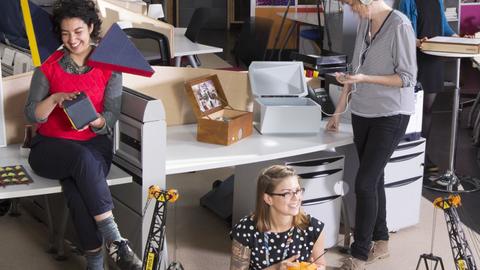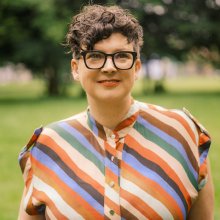
Clare Reddington CEO
on Tue 13 Nov 2018Beyond innovation: understanding Artists as leaders
Posted on Tue 13 Nov 2018
A short provocation on Artists as Leaders, the difference between innovation and invention and the danger of constraining the latter with the metrics of the former, given at Beyond Conference to launch AHRC's Clusters investments.
“These are powerful times. The world has outstripped our capacity to understand it. The anchors of identity, morality, cultural coherence and social stability are unravelling. We are losing our bearings”. We are living, as asserted beautifully by the International Futures Forum, in a conceptual emergency.
And, as John Seely Brown would have it - in times of rapid change, to deliver new ways of working, thinking and being, to deliver new types of content, product or experience, - we need to work with people who are not like us; in size, discipline, sector, cultural background, ability, class or outlook.
I have been quoting Creation Nets in conferences for a decade and everyone seems to heartily agree with this notion of designing in difference as both an innovation and social imperative, and yet it is the thing that is neglected. Sometimes (OFTEN) it feels like even in the creative sector, we would like change as long as it looks exactly like what we have always done.
So, I am here to talk about why engaging artists as inventors of the creative economy is a good plan, in order to counteract all of the ‘there is actually no change’.
But I thought I would start by underlining the difference between innovation and invention:
Invention is the magic. It is the spark of an idea, it is a new way of doing something.
Innovation is how we grow that idea, the systems needed to make it scale-able, replicable, stable.
Invention doesn’t happen in silos, it isn't about respecting what has been done before, or acting within the cannon. Doing new stuff is hard. Inventive leaders are not lonesome heroes in ivory towers, but people whose energy is piqued by open-ness and collaboration. They are people who think inclusively not hierarchically.
I believe that inventiveness is a key characteristic of being an artist. I asked Twitter what they thought an artist is, and got quite the avalanche of thinking:
Renowned play academic Matthias Poulson said: “A person who think it's ok to play with the world; who has the capacity to see the world through a different lens”.
Jason Crouch offered “Artists are influenced by external forces but not beholden to them”
van Gogh (who did not tweet me) felt an artist was someone who was not afraid to do something wrong sometimes, not afraid to lapse into some mistakes. To want to be ‘good enough’ leads to stagnation, to mediocrity.
One of my favourites was from Tom Morris of Bristol Old Vic: “An artist sees the world with startling clarity, often from an unusual point of view, and has the craft and wit to share those insights with the rest of us”
Most of these ways of defining artistic practice come down to ways of seeing the world differently. And OH we need leadership that is not beholden to untrustworthy corporates, inventors who are playing in the real world not the lab or the campus, people who consider the route to market is NOT the only pertinent question.
Artistic practice, as a place of invention, is a precious bastion of original thinking, provocation and magic. It is the lifeblood of the creative economy.
YES some of you may say, but what does that actually look like? A few examples from Watershed:
The Pervasive Media Studio
The Pervasive Media Studio at Watershed is a world-leading centre developing talent and emergent practice in the cultural and creative economy. It is a partnership with UWE Bristol and University of Bristol. Bringing artists and technologists together for ten years, our ethos of open-ness and generosity has spread around the world.
Layered Realities
Watershed and the Smart Internet Lab at the University of Bristol explored the potential of 5G through a series of experimental events - asking artists, researchers and creatives to produce bold new works in public space. It was the world’s first urban testbed for public users. We asked artists and creatives to really test its capability and potential - in response they have created some brilliant, meaningful experiences ranging from spectacular 3D-like projections, a gorgeous virtual reality dance piece, a guided tour on which you take a walk through time, and a programme of critical talks.
Playable City
Playable City puts art and culture at the heart of the future city, re-using city infrastructure and re-appropriating smart city technologies to create connections – person to person, person to city. Playable City is active across five continents in cities as diverse as Recife, Bristol, Lagos and Tokyo – in each place it has created a connected innovative community of interest exploring their own city’s issues and opportunities.
Shadowing gives memory to the city street lights, enabling them to record and play back the shadows of those who pass underneath. Winner of the 2014 Playable City Award, Shadowing was created by Chomko and Rosier. Shadowing has appeared in Bristol, York, Tokyo, Tel Aviv, London and Austin Texas.
VR
Jane Guantlett’s first immersive works explored what it feels like to be one of her seizures. Her in my shoes series has gone on to ask important questions about love, sexuality and intimacy - exploring the form of VR, the audience experience, what immersive technologies are for.
I believe that artists can and do invent the future - but i also know that we can fuck this up easily if we are not careful with it:
In Upstream, poet Mary Oliver contrasts how we think about ordinary selves with that of the creative self (Thanks David Owen): She asks us to imagine...
“What do you ask of the pilot when you climb aboard a plane? You hope they will not daydream. You want this flight to be ordinary, not extraordinary. So, too, with the surgeon, and the ambulance driver, and the captain of the ship. Their ordinariness makes the world go round. In creative work — creative work of all kinds — those who are the world’s working artists are not trying to help the world go around, but forward. Which is something altogether different from the ordinary. Such work does not refute the ordinary. It is, simply, something else. Its labor requires a different outlook — a different set of priorities.”
And yet we take the systems of innovation and apply them to invention.
The metrics of the ordinary are used to capture and pin down the creative.
So I am asking that when we work with art as a practice or a profession, let us:
Fund it properly.
Treat it equally.
Act inclusively.
Let us be kind and thoughtful with IP, with payment terms, with organizational culture and with how we welcome people.
Let us acknowledge that by relishing difference we will need to act differently ourselves. We will need to find new ways to grow invention into innovation.
Perhaps pausing the counting of outputs long enough to notice what is useful to count?
The UK has powerful creativity but we do not want to emulate the problems of silicon valley. The clusters are important place-based investments where inclusion, talent and diversity will be key.
Valuing art and creativity alongside diversity and talent is the driving force of the Bristol and Bath cluster. I hope you will join us in finding new ways to value and champion difference.

